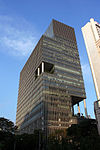Boat Quay

Boat Quay is a historical quay in Singapore which is situated upstream from the mouth of the Singapore River on its southern bank. It spans from the shophouses near UOB Centre, stretching along one bank of the Singapore River, all the way till Elgin Bridge. It was the busiest part of the old Port of Singapore, handling three-quarters of all shipping business during the 1860s. Because the south of the river here resembles the belly of a carp, which according to Chinese belief is where wealth and prosperity lay, many shophouses were built, crowded into the area. Though serving aquatic trade is no longer Boat Quay's primary role, the shophouses on it have been carefully conserved and now house various bars, pubs and restaurants. Therefore, Boat Quay's social-economic role in the city has shifted away from that of trade and maritime commerce, and now leans towards more of a role accommodated for tourism and aesthetics for the commercial zone of which encloses the Singapore River. It is the soft front to the cosmopolitan banking and financial sectors lying immediately behind it. Boat Quay is also the name of the road along the quay, which has since been converted into a pedestrian mall.
Excerpt from the Wikipedia article Boat Quay (License: CC BY-SA 3.0, Authors, Images).Boat Quay
Boat Quay, Singapore Singapore River
Geographical coordinates (GPS) Address Nearby Places Show on map
Geographical coordinates (GPS)
| Latitude | Longitude |
|---|---|
| N 1.2868472222222 ° | E 103.84951111111 ° |
Address
Boat Quay 46
049858 Singapore, Singapore River
Singapore
Open on Google Maps











